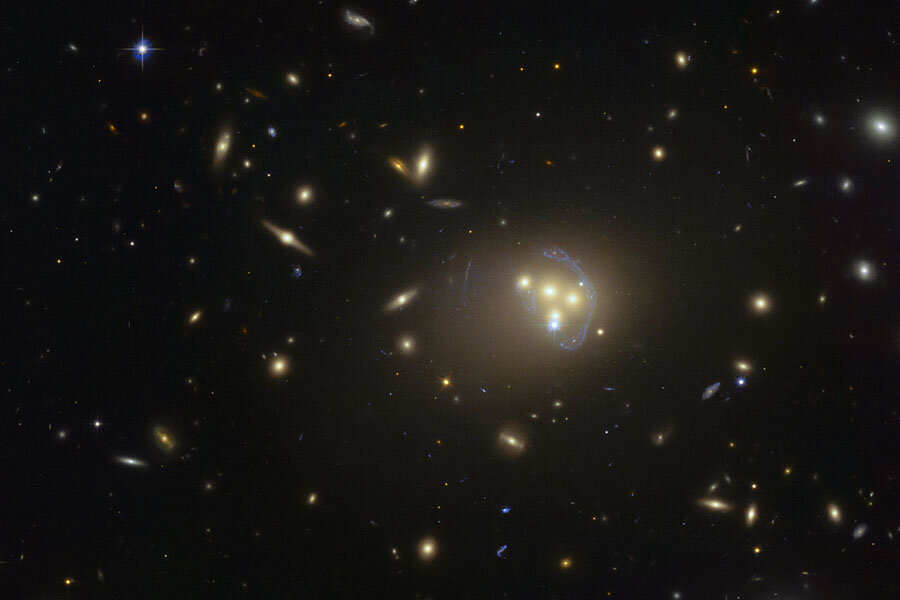Galactic collisions rattle current theories of dark matter
Loading...
A quartet of colliding galaxies in a vast cluster 1.4 billion light-years away may prompt scientists to rethink their notions about the nature of dark matter – a hidden form of matter that makes up some 85 percent of all the matter in the universe.
Dark matter forms cocoons in which galaxies and clusters of galaxies form. Its gravity holds galaxies together. It's "dark" because, as currently conceived, it rarely, if ever, interacts with ordinary matter, or even itself, other than through gravity.
Out at the cluster, known as Abell 3827, hints have emerged that dark matter may be less reclusive than previously believed. Three of the four merging galaxies appear to be sitting in the middle of their own dark-matter halos, as theory predicts. The fourth halo, however, appears to be trailing its galaxy like a reluctant retriever tugging at the end of a 5,000-light-year-long leash.
Unless astrophysicists can come up with and verify a more prosaic reason for the offset, which still could happen, this could be the first hint that dark matter does interact with other dark matter and by a means other than gravity.
If dark matter turns out to interact with itself, the implications could be profound, researchers say.
It would provide confirmation at the cosmic level that a new physics frontier lies beyond the standard model of physics, which describes a zoo of subatomic particles and their interactions. The standard model has no candidates for dark-matter particles, explains Dan Hooper, an astrophysicist at the Fermi National Accelerator Laboratory (Fermilab) in Batavia, Ill.
Confronted with self-interacting dark matter, physics then would have to do more than identify the subatomic particle associated with dark matter itself. They also would have to propose particles that in effect govern the interactions.
"There is a huge difference between zero interactions and even teeny tiny interactions," explains Richard Massey, an astrophysicist at the Institute for Computational Cosmology at Durham University in Britain and the lead author of a formal description of the Abell 3827 observation, published this week in the Monthly Notices of the Royal Astronomical Society.
"If dark-matter particles interact, they need another particle to interact through. Then you have at least two species – which see each other – and potentially have the bare bones of chemistry," adds Dr. Massey in an e-mail.
The notion that the universe is full of dark matter first cropped up in the early 1930s as astronomers noted that if the gravity from all the visible matter in a rotating galaxy was the only gravity at play there, it would be too weak to hold the galaxy together. More recently, large accumulations of dark matter associated with clusters of galaxies have been enlisted as gravitational lenses. Their intense gravitational fields bend light in ways that mimic optical lenses.
Later, astronomers tried to fit several types of dark matter into their models of the cosmos's evolution. The type of dark matter that seemed to provide the best fit to the structure the universe currently displays was so-called cold dark matter.
The idea that dark matter may be self-interacting emerged about 15 years ago, but has gathered momentum over the past five years. When exploring the universe at small scales, cold dark matter appeared to run into problems, says Fermilab's Dr. Hooper, who did not take part in the new study.
For instance, simulations fed with cold dark matter produced a Milky Way with more satellite galaxies than it currently hosts. The simulations also produced dwarf galaxies whose dark matter was distributed differently than they are in observations.
One way to resolve what Hooper calls these "would-be" problems is to replace cold dark matter with self-interacting dark matter in the simulations.
Last year, a team that included one of Massey's colleagues, Liliya Williams, an astrophysicist at the University of Minnesota, reported evidence from ground-based telescopes that Abell 3827 appeared to host a galaxy that had become separated from much of its dark matter.
She, Massey, and colleagues followed up with observations using the Hubble Space Telescope and the European Southern Observatory's Very Large Telescope – an array of four 8.2-meter telescopes on a mountaintop in Chile's Atacama Desert.
By taking advantage of dark matter's gravitational lensing, the team was able to show that three galaxies fall within their dark-matter halos. The fourth did not.
The interaction the observations imply are weak compared with the strength of interactions researchers typically associate with self-interacting dark matter, Hooper says. But observations by Massey's team would suggest that the interactions at Abell 3827 still are pretty strong.
The team cautions that the offset could be due to astrophysical effects rather than interactions among concentrations of dark matter. And the confidence level the team attributes to its findings don't rise to the level of smoking gun.
Still, the researchers note that such offsets do not appear among isolated galaxies, suggesting that the offsets have something to do with the large environment in which the galaxies find themselves.
"It's a hint," Hooper says, "and it merits further investigation."
That investigation will be aided by dark-matter maps being compiled by a project undertaking a survey of dark energy, another cosmic conundrum, Massey writes. Dark energy, discovered in the late 1990s, is accelerating the expansion of the universe. The goal is to use the maps and changes in the lumpiness of dark matter over cosmic time to track the influence of dark energy.
Scientists with the international project, called the Dark Energy Survey, released the first set of maps covering 2 million galaxies at a meeting of the American Physical Society in Baltimore this week.
"The art is knowing where to look" for other clusters with galaxies that may be leaving some of their dark matter in the dust, Massey notes. These maps could help point the way.








